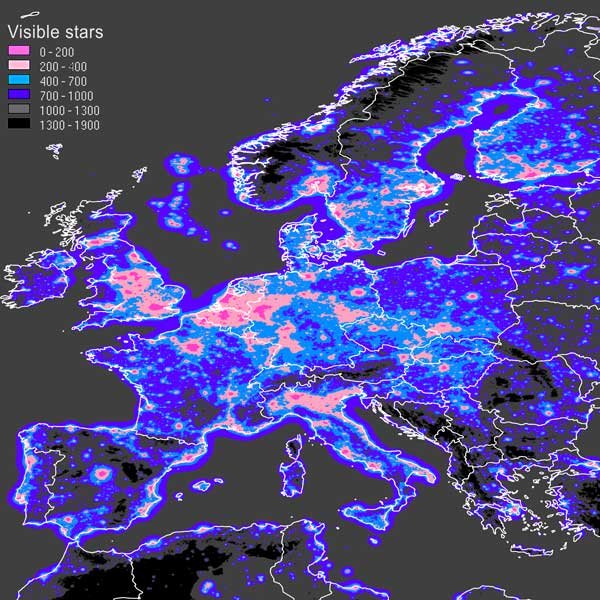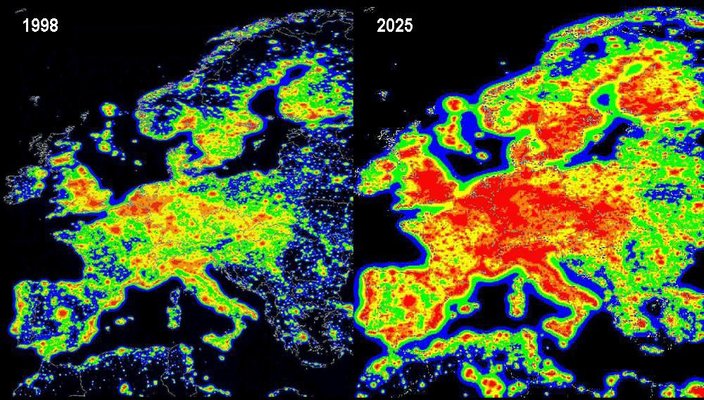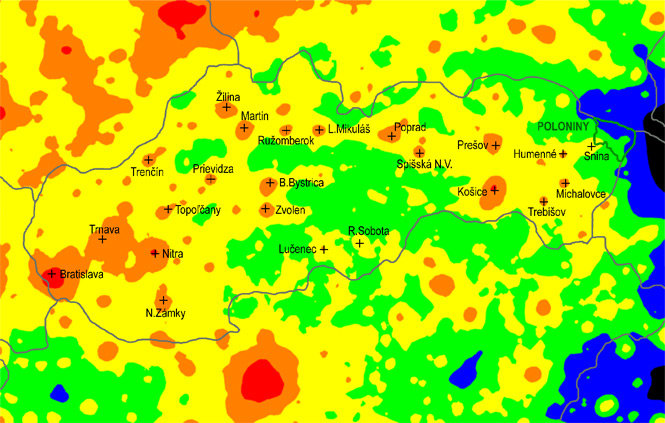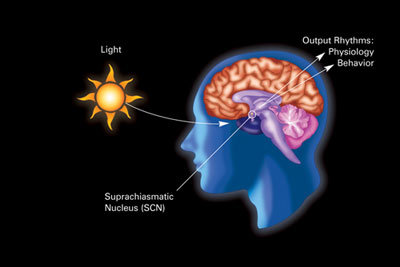Are we light polluted?
An arm and a leg for the darkness. Do you find it ridiculous? Why do we even need the true darkness?
The environmental pollution is a huge problem of the age. We are all aware of that. What about the light pollution? Astronomic researches have proved the night sky brightness is increasing exponentially. If it keeps increasing at the same pace, in 30 years we will be able to watch the Milky Way only on pictures, according to the scientific researches results. The stars will disappear. Of course, not really. We just won´t be able to see them.
The Light Pollution Science and Technology Institute, an Italian NGO, did the job and provided us a map that show how many stars are actually visible to us at the night sky just by the naked eye. As you can see, Slovakia is not the worst place to observe the stars, but it is not the best one either. Yes. Consciously or not, we deny ourselves a beauty of many stars.

A very first man, who decided to monitor the European sky brightness systematically, was P. A. Cinzano. Mr. Cinzano and his team compared the data obtained in 1998 and available data from 1971 and prepared a prognosis for the 2025. Their project was the first one to map the sky brightness in Europe with resolution higher than 3 km.

The picture below shows a detailed situation in the Slovak sky. Not many romantic moments under the starry sky to be expected in Bratislava, Trnava or other bigger towns polluted by the light. On the other hand, there are still plenty of good spots for night sky observations in the mountains and other more remote places. Unfortunately, there are no black zones in Slovakia. That means we would have to leave our homeland to see the true darkness and a shiny marble Milky Way.
Anyway, if you refuse to cross the border and still want to witness the darkest darkness, a night trip to Poloniny Mountains can be your choice. Is only right the Poloniny National Park is sometimes called „A dark sky park“. It is the darkest zone in Slovakia. There is no artificial light to disturb the living creatures´ night biorhythms, so the concentration of endemic and endangered plant, fungi and animal species is very high.

An arm and a leg for the darkness, as said in a Czech TV documentary. Watch the following video - you can learn about the reasons of the light pollution, how it affects human beings, animals and plants and also about the possible solution of the problem.
Sme zašpinení svetlom? Pozrite sa, čo všetko "dokáže" svetelné znečistenie.
Posted by Freya LED on 27. október 2015
Don´t get confused
The consequences of the light pollution are quite serious. Everything on the planet, human beings, animals and plants, has evolved with an alternation of day and night. The artificial light disrupts the natural alteration and so affects the circadian rhythm. It has many negative effects on ecosystems. Deny it or not, human beings are a part of ecosystems, and are also deeply affected by the changes of the natural light alterations.
Effects on animals and plants
- We are the reason why many animals get confused. Many animal species desperately need the true darkness so they can rest or be active (feeding, navigation, mating, luring the prey...). An improper artificial night-light confuses migratory birds, fish, turtles and bats. For the insect it becomes a lethal trap (yes, the insect is endangered, too).
- The light pollution is the reason for late falling of leaves and premature trees and plants death, as it interferes with the photosynthesis.
Effects on humans
- Changes in the circadian rhythm deeply affect the mental state and human behaviour and cause mood disorders.
- Light intensity and quality play an important role in hormone production and overall body functionality. The risk of cancer may be increased due to lack of the true darkness during the nigh sleep, according to the doctors. The melatonin, a hormone that protects our body from malignant tumour growth, the hormone of the dark and sleep, can only be produced while sleeping in the dark.
- A dazzling light is often guilty of car accidents.
"A healthy light criteria" (environmentally friendly, does not damage the sight, positively affects the learning velocity, does not cause fatigue, annoyance, sleeping problems, headache, anxiety or concentration disorders) lately becomes a serious rival of economic aspects when choosing the proper light.

How to remove the light pollution?
There is a positive fact in the entire story. Mostly, no complicated and expensive solutions are needed. Little changes can be enough. How to minimize the light pollution as much as possible? Here you are, an advice to take away. Served.
1. Don´t light your way to up the sky - the most trivial advice. No need to point the light to the windows, illuminate the sky or walls. None appreciates that. Use the light effectively - point it only where really needed.
2. Don´t shine all day long - of course, personally you can. Just turn your lights off when none needs them.
3. Don’t save by saving up - do you think is better to keep the old lights till they definitely die and replace afterwards? You surely know the answer. Dig deep into your pocket for once and get top shelf LED lights with quick return on investment. In the short run, your budget will hate you; in the long run (in a few years) it will love you eternally. Just as humans and animals, not tortured anymore by your unpleasant lights.
Sources:
- http://www.lightpollution.it/dmsp/numstar.html
- http://www.lightpollution.it/download/cinzano_nightskyeurope.pdf
- http://poloniny.svetelneznecistenie.sk/park-tmavej-oblohy/kvalita-oblohy/
- http://lp.begi.sk/1413ruzomberok/rapavybegeni.pdf
- http://www.ceskatelevize.cz/ivysilani/1095913550-nedej-se/415235100161004-tma-nad-zlato
- http://www.ekoporadna.sk/poradca-ekospotrebitela/zdrave-a-zelene-byvanie/72-svetelne-znecistenie.html
